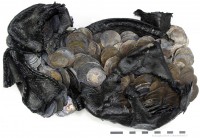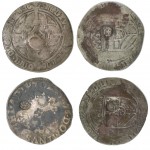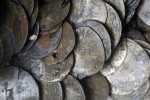 Archaeologists surveying the construction site of the former City Hall in Rotterdam have unearthed a collection of 477 coins stuffed inside a 16th century shoe. The oldest coin in the hoard dates to 1472 and the most recent to 1592. The shoe, its leather still in quite good condition, is a 16th century style. Experts believe it was buried in 1592 or shortly thereafter, under the floorboards of a house by the owner, either as a standard savings practice (like the proverbial keeping your money in your mattress) or out of fear that they might be lost or stolen during turbulent times.
Archaeologists surveying the construction site of the former City Hall in Rotterdam have unearthed a collection of 477 coins stuffed inside a 16th century shoe. The oldest coin in the hoard dates to 1472 and the most recent to 1592. The shoe, its leather still in quite good condition, is a 16th century style. Experts believe it was buried in 1592 or shortly thereafter, under the floorboards of a house by the owner, either as a standard savings practice (like the proverbial keeping your money in your mattress) or out of fear that they might be lost or stolen during turbulent times.
Most of the coins are Netherlands nickels, half pennies and double nickels. There are also English and Spanish pieces. At that time, foreign currency was just as usable as local coin. It was the quality and weight of the silver that counted. Some of the coins show signs of having been tested for value; they’ve been pierced to see if they’re real silver through and through. The total worth of the hoard in 1592 would have been around 50 guilders. To give you an idea of the buying power, a skilled craftsman earned a little less than one guilder a day, so this collection amounted to about two month’s pay.
 The place where they were discovered was the location of a City Hall built after the destruction of the old one during World War II. It hasn’t been a private home in centuries, which makes the survival of the coin-filled shoe even more remarkable.
The place where they were discovered was the location of a City Hall built after the destruction of the old one during World War II. It hasn’t been a private home in centuries, which makes the survival of the coin-filled shoe even more remarkable.
The late 16th century was a particularly rocky time for Rotterdam and the rest of the Netherlands. In 1568, the Seventeen Provinces (comprising all of today’s Netherlands, Belgium, Luxembourg, plus bits of France and Germany) rebelled against the rule of the Spanish King Philip II. Religious conflict was the immediate catalyst. Philip was keen to enforce anti-heresy edicts in his heavily Protestant territories. Those territories were used to Charles V’s lax attitude; they didn’t appreciate having the Inquisition breathing down their necks. A burst of Iconoclastic fury by Dutch Calvinists in 1566 resulted in a brutal crackdown by the Duke of Alba, the Spanish military commander. A thousand people, among them nobles of the highest rank, were executed for treason.
William of Orange was supposed to be one of them, but he escaped and launched a revolt from Germany. Rotterdam sided with the rebellion in 1572 and became part of the Republic of the Seven United Netherlands when the Dutch Low Countries seceded from the Spanish crown in 1581. Philip wasn’t going to let them go without a fight and a fight they got. Philip’s nephew, Alessandro Farnese, Duke of Parma, successfully led the Spanish army to reclaim Belgium and the southern Netherlands in 1585 and put constant military pressure on Holland, at this point garrisoned by ineffectual British troops under Robert Dudley, the Earl of Leicester and Queen Elizabeth’s favorite.
Spanish army to reclaim Belgium and the southern Netherlands in 1585 and put constant military pressure on Holland, at this point garrisoned by ineffectual British troops under Robert Dudley, the Earl of Leicester and Queen Elizabeth’s favorite.
The Dutch Republic’s fortunes improved with the defeat of the Spanish Armada in 1588 and with Philip’s involvement in the French Civil War in 1589. Parma’s troops were spread too thin while the Dutch Army instituted revolutionary reforms which transformed it into an effective fighting force. In the early 1590s, the Dutch took the offensive, besieging Spanish-held cities with much success.
 There was no official truce between the Republic and Spain until 1609. Fortunes shifted and anybody living in Holland during this period would have had good reason to hoard coin. Yet, such hoards are rare finds, and this is the first one that has ever been found in a shoe. Next up, Rotterdam’s Archaeological Research Center will clean the coins and study the find in more detail.
There was no official truce between the Republic and Spain until 1609. Fortunes shifted and anybody living in Holland during this period would have had good reason to hoard coin. Yet, such hoards are rare finds, and this is the first one that has ever been found in a shoe. Next up, Rotterdam’s Archaeological Research Center will clean the coins and study the find in more detail.
Here’s a nifty YouTube of the excavation. It’s all in Dutch and there are no subtitles, so if there’s any information in there I should add to this entry, please do let me know in the comments.
And now, a composition of my own, inspired by the nursery rhyme that immediately leaped to mind when I read this story. Throat clearing. One arm up in declamation position.
There was an old coin hoard that lived in a shoe.
Nearly 500 pieces made a shimmering debut
Under the late City Hall, now a great gaping hole,
After five troubled centuries spent safe in their sole.
***
Thank you. Thank you very much.